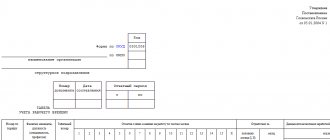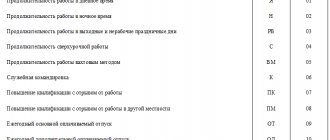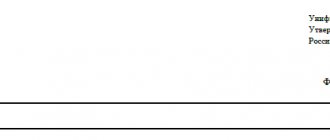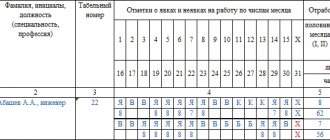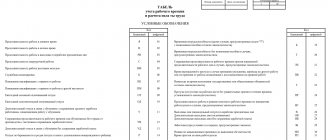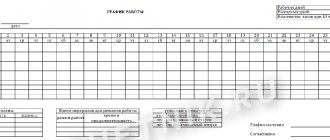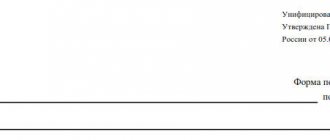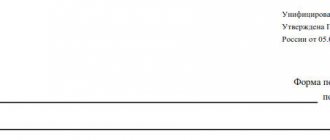Absenteeism must be correctly reflected in the standard time sheet for settlement with the employee. It may be required as one of the evidence of failure to appear, which is taken into account by the court. There are certain standards for writing report cards. An employee does not have the right to argue with termination of a contract for absenteeism in 2 cases:
- The boss imposed penalties within 30 days from the date of detection of absenteeism;
- The employer has compelling arguments.
That is why it is so important to follow all the rules for preparing time sheets.
What signs to put if the employee does not show up for work?
When a worker is absent from work for unknown reasons (there are no necessary documents about the reason for absence), without notifying the personnel service and the manager of his absence, the letter “NN” is entered on the report card (24).
This code is recorded until the employee enters the workplace.
Please note: an employee can be punished for being absent from work. The Labor Code provides for only three types of punishment - reprimand, reprimand and dismissal.
How is unexcused absence noted?
Even if the manager informs you about an employee’s absenteeism, there is no need to rush to enter the absenteeism code “PR”. You should wait until the absent specialist brings a paper with explanations.
If the reason for absence is not valid, “PR” (30) is written on the report card.
There are cases when absenteeism designations are indicated, and the employee was absent for valid reasons. Consequently, the timesheet submitted to the accounting department is incorrect and requires correction.
The Labor Code of the Russian Federation does not regulate circumstances that are valid under the unified regime. That is, the law requires employers to independently determine whether each individual situation is a valid reason for the absence of subordinates from work.
As a rule, the following reasons are considered valid:
- employee illness;
- death of a close relative of an employee;
- natural disasters, fire;
- road traffic accidents.
When determining the validity of a reason, one should be based on the principles of reasonableness and fairness.
Do not forget about the need to draw up a report in the event of a specialist’s failure to show up for work.
If there are no plans to take disciplinary action against the resigning employee, then it is possible to arrange for the employee to take leave without pay.
How are no-shows indicated - sample filling out T-13
There are 2 options for filling out the timesheet: continuous (a designation is entered for each day) and by deviations (only delays and omissions are noted).
There are no clear instructions on how to fill out the timesheet; for each enterprise, information is recorded in the timesheet based on practical skills. If the letter designation in the report card seems more convenient, they are used, otherwise numbers are used.
On the timesheet form, in the top line, data on the employee’s absence is recorded - NN, PR, the bottom line remains blank. For the final calculation of hours worked for the month, these days are not taken into account.
If an employee has been absent for more than 4 hours in a row, the employer legally registers absenteeism. Other cases of employee absence will not constitute a violation of labor standards.
In practice, there are situations when an employee was absent not the entire working day, but only for a few hours. In this situation, it is necessary to indicate the fact of absenteeism and partial attendance. For a unified report card form, a double code is used - “I/PR”; hours worked and hours missed are indicated through a fraction.
An example of filling out a time sheet in case of absence without a valid reason for 1 hour:
conclusions
Absenteeism is an employee’s misconduct, for which he can pay with his job.
The employer can also show leniency by issuing a reprimand, reprimand, or even not applying any punishment to the offending subordinate.
Violation of labor regulations must be documented, otherwise the enterprise will not be able to prove its case in a judicial body.
Before making a decision on imposing disciplinary action, the employer needs to find out whether the deadline for this action has expired. This type of dismissal must adhere to the provisions of Art. 193 Labor Code of the Russian Federation. Collection is allowed no later than 30 days from the date of discovery of the misconduct; the employee’s time of illness or vacation is not taken into account.
Didn't find the answer to your question in the article?
Get instructions on how to solve your specific problem. Call now:
+7 ext.445 — Moscow — CALL
+7 ext.394 — St. Petersburg — CALL
+7 ext.849 — Other regions — CALL
It's fast and free!
In order to understand what type of time (work, day off, holiday, etc.) is reflected in the working time sheet, certain codes are used - alphabetic or digital. Letter ones are used more often because they are visually more informative.
Article 81 of the Labor Code of the Russian Federation in 2020-2021
In Art. 81 of the Labor Code of the Russian Federation, namely sub. “a” clause 6 states that in case of absenteeism, the employer can legally dismiss the employee. In this case, the conditions mentioned earlier must be met.
But should a manager always fire an employee for absenteeism? This article gives him the right to do this, but does not establish such an obligation. Legislators leave the right of choice to the company's management. It can reprimand the employee, reprimand him or simply leave absenteeism unattended.
In some cases, the dismissal of an employee is possible due to him going on unauthorized leave without warning management. Every enterprise must have an annual vacation schedule. It is brought to the attention of employees. Lack of a schedule is considered a violation of labor laws.
Find out how to properly create a vacation schedule and download the form on our website. Read the article “Vacation schedule - form and sample for filling out in 2021.”
But in any case, going on vacation without the approval of management is a violation of labor discipline, and the employee may be held accountable for absenteeism.
You may also find these articles useful:
- “How to properly arrange leave followed by dismissal?”;
- “Order for annual paid leave - sample and form”.
Sometimes it happens that absenteeism ends the employee’s desire to resign of his own free will. The employee writes a letter of resignation and, without working for 2 weeks, does not go to work at the scheduled time.
If an employer dismisses an employee for absenteeism, he makes a corresponding note in his work book with reference to Art. 81 Labor Code of the Russian Federation.
Symbols in the time sheet
Most enterprises still use unified letter designations in the report card, since they are the most convenient to use and cover almost all situations.
Codes for working hours
The following codes are used to indicate working hours:
- “I” – denotes the employee’s performance of job duties in normal working mode;
- “N” – working hours from 22-00 to 6-00, that is, work at night;
- “RV” – going to work on weekends and holidays;
- “K” – the employee is on a business trip, regardless of whether it is a working day or a holiday;
- “C” – hours of overtime work, in cases where overtime can be determined only based on the results of the month, it is entered only in the final columns of the time sheet;
- “RP”, “VP” and “NP” - denote downtime in the working time sheet: due to the fault of the employer, employee and due to circumstances independent of the will of the parties, respectively.
These are the most commonly used codes.
Codes to indicate employee absence
To indicate the time when a person does not perform his official duties, the following letter designations are used:
- “B” - weekends and holidays when the employee rested;
- “B” and “T” - in the report card indicate temporary disability, paid and unpaid, respectively;
- “OT” – duration of annual paid rest (vacation);
- “OD” in the report card indicates additional leave, which is paid;
- “P” – this code denotes sick leave, which is given to a woman in connection with pregnancy and childbirth;
- “OZH” in the report card - the decoding of this code means leave granted to care for a child;
- “U” and “UD” – study leaves, paid and at your own expense, respectively;
- “BEFORE” - means vacation at your own expense, that is, without accrual of payment;
- “PR” – absenteeism established during an internal investigation;
- “NN” in the report card - the decoding of this code indicates the absence of an employee for unknown reasons. As a rule, it is subsequently replaced by one of the above reasons for absence from work.
You need to consider in more detail this type of time a person is absent from the workplace as time off. There is no designation for it on the report card. It will depend on how the time off is documented.
The fact is that there is no such concept as time off in the Labor Code of the Russian Federation; by default, this term refers to the following types of rest:
- Providing a day of rest at a time convenient for the employee, in the case when he worked on his days off (indicated by code “B”);
- One day provided to the employee at his own expense (indicated by the OD code);
- An employee’s absence from work by agreement with the employer, only upon application, without being reflected in the report card (will be reflected with the letter “I”). Although this case goes against labor laws.
In order to establish what type of time is reflected in the timesheet, letter codes are used. They can be found in the unified report card T-12. The employer is not obliged to use them, but can approve his own symbols.
>Designations and codes in the time sheet
Why is this necessary?
- So that managers and employees remember that their colleague is currently on vacation and take this into account in their own and production plans.
- So that the employee soberly calculates his strength and closes as much as possible before the vacation or transfers all his unfinished cases to other employees of the department, reports on time and reports to his immediate supervisor.
- So that a few days before the start of the vacation, the employee is not added new tasks, cases or assignments that he cannot complete for objective reasons, but they are evenly distributed among other employees.
- So that managers can plan vacations for their employees throughout the year without compromising production interests.
- To minimize the factor of human error and simple forgetfulness.
Are you tired
You may be tired both physically and mentally. No one is immune from the fact that you will have the honor of unloading a car full of some nonsense for half a day at work, or you will fail a chemistry test. As practice shows, 92% of injuries during training are due to inattention, absent-mindedness and physical exhaustion. Therefore, your fatigue will certainly lead, at best, to a sprained or nailed dumbbell finger. When you are really tired, it is better to postpone the workout to the next day.
When you are sick or have a fever
Everything seems to be clear here. If you are sick, stay at home. Your zeal will not end well. Any strength and aerobic exercise will lead you to incurable diseases of the cardiovascular system. In addition, if you come to the hall even slightly snotty, you will infect all your colleagues in the iron shop. After all, our gyms are rather cramped places, and there are always problems with ventilation in them. If one sneezed, tomorrow everyone came down with the flu.
Symbols in the time sheet in 2021
The report card can use alphabetic or numeric codes to indicate a particular event, for example, attendance at work has the letter I or 01 in digital expression, absenteeism - PR or 24, additional days off without pay - NV or 28.
Timesheet codes (2019) - a complete list of alphabetic and numeric characters - are contained on the first page of Form T-12.
| Code | ||
| alphabetic | digital | |
| Duration of work during the day | I | |
| Duration of work at night | N | |
| Duration of work on weekends and non-working holidays | RV | |
| Overtime duration | WITH | |
| Duration of work on a rotational basis | VM | |
| Business trip | TO | |
| Advanced training without work | PC | |
| Advanced training with a break from work in another area | PM | |
| Annual basic paid leave | FROM | |
| Annual additional paid leave | OD | |
| Additional leave in connection with training while maintaining average earnings for employees combining work with training | U | |
| Reduced working hours for on-the-job trainees with partial pay retention | UV | |
| Additional leave in connection with training without pay | UD | |
| Maternity leave (leave in connection with the adoption of a newborn child) | R | |
| Parental leave until the child reaches the age of three | coolant | |
| Unpaid leave granted to an employee with the permission of the employer | BEFORE | |
| Leave without pay under the conditions provided for by the current legislation of the Russian Federation | OZ | |
| Additional annual leave without pay | DB | |
| Temporary disability (except for cases provided for by code “T”) with the assignment of benefits in accordance with the law | B | |
| Temporary disability without benefits in cases provided for by law | T | |
| Reduced working hours versus normal working hours in cases provided for by law | Champions League | |
| Time of forced absence in the event of dismissal, transfer to another job or suspension from work being declared illegal, with reinstatement to the previous job | PV | |
| Absenteeism while performing state or public duties in accordance with the law | G | |
| Absenteeism (absence from the workplace without good reason for the time established by law) | ETC | |
| Duration of part-time work at the initiative of the employer in cases provided for by law | NS | |
| Weekends (weekly vacation) and non-working holidays | IN | |
| Additional days off (paid) | OB | |
| Additional days off (without pay) | NV | |
| Strike (under conditions and in the manner prescribed by law) | ZB | |
| Absences for unknown reasons (until the circumstances are clarified) | NN | |
| Downtime caused by the employer | RP | |
| Downtime due to reasons beyond the control of the employer and employee | NP | |
| Downtime due to employee fault | VP | |
| Suspension from work (preclusion from work) with payment (benefits) in accordance with the law | BUT | |
| Suspension from work (preclusion from work) for reasons provided for by law, without accrual of wages | NB | |
| Time of suspension of work in case of delay in payment of wages | NZ | |
Unified uniform T-12
It should be noted that the unified form T-12 can be used in any organization, regardless of the form of ownership, except for budgetary institutions.
In budgetary institutions, an accounting form is used, approved by order of the Ministry of Finance of Russia dated March 30, 2015 No. 52n, which uses other digital and letter designations in the working time sheet.
Categories
You will learn:
- What does the concept of “truancy” include and what are the measures to prevent losses from absenteeism
- How to correctly record an employee’s absence from work
- What measures can an employer take in relation to a truant worker?
In any organization, it happens that employees do not go to work. Sometimes, even if there are good reasons (for example, illness), the employee not only does not report his absence to the employer, but also does not confirm his absence from work with supporting documents. In this case, failure to appear is considered absenteeism.
But there are situations in which it is difficult to understand immediately: for a good reason, the employee stopped going to work or not, in which situations he can be fired, and in which - absolutely not. Often, a situation that is clear at first glance turns out to be far from being so simple upon further examination.
How to correctly assess the situation? What documents should be completed and within what time frame? How to prevent violations of labor laws? We will consider these and other questions in this article.
MEASURES TO PREVENT LOSSES FROM ABSENTANCE
The absence of an employee from work, even for a short time, disrupts the work process. To minimize damage, the organization must take a number of measures:
- The internal labor regulations must contain a clause obliging the employee to warn his immediate supervisor in advance about the inability to go to work, the reasons for absence and the expected period of absence. Fulfillment by the employee of the relevant obligations will help the manager make timely decisions on the distribution of the responsibilities of the absent employee among his colleagues;
- The head of a structural unit must have a list of employees whom he can entrust to perform the functions of an absent employee. The employees themselves, in turn, must be aware of the colleague’s affairs, which they will need to carry out in the event of his absence (not only unexpected, but also planned (for example, during a vacation or business trip));
- the manager must have specific instructions regulating his actions in the event of an employee’s absence without warning (example 1).
The instructions are of an auxiliary nature; they do not have to be issued on the organization’s letterhead and certified by the signature of the manager. The main condition is that they must contain a specific algorithm of actions.
Example 1
Memo to the head of the department on actions in case of employee absence
- Call the employee at all telephone numbers known to you (home, mobile, etc.) and find out the reason and possible duration of his absence.
- Ask your subordinates whether the employee has spoken about possible absence from work. If one of the employees is aware of the reasons for a colleague’s absence, ask them to state them in a memo addressed to the head of the organization.
- Draw up a report on the absence of the employee, the measures taken to find him and their results.
- Take all documents to the HR department and receive instructions there on further actions regarding the absent employee.
Specify in the documents as clearly as possible the employee’s workplace (workshop, machine, office number. If you have a chain of stores and regularly rotate staff, such specificity, on the one hand, will complicate the work of personnel services, increasing the document flow, and on the other hand, will protect the interests of the employer.
SCIENTIFIC EDITOR'S NOTE
A workplace is a place where an employee must be or arrive in connection with his work and which is directly or indirectly under the control of the employer. According to Part 4 of Art. 57 of the Labor Code of the Russian Federation, the condition of the employment contract about the workplace is an optional (that is, optional) clarification of the condition about the place of work. We recommend (if necessary) that the employee be assigned to a workplace not by an employment contract (in order to avoid subsequent problems with changing this condition of the employment contract), but by a unilateral document (an order for the organization, an order for the division, a notification, etc.).
When registering a part-time employee , focus his attention on the fact that part-time work (as opposed to freelancing) is carried out regularly , he is entitled to leave, as at his main place of work, but it is prohibited to go there without permission. As practice shows, many workers perceive part-time work as additional income if they have free time, not realizing that a second job involves the same obligations as when performing the main one.
THE EMPLOYEE DIDN'T GO TO WORK: WE FIX A NO-SEE
On the first day of an employee’s absence from work, we cannot be sure that he is absent (or even absent) and not sick.
A clear record of absence will help if the fact of absenteeism is confirmed over time, and will not hurt if the employee brings a certificate of incapacity for work . The failure to appear report must be drawn up in the presence of two witnesses. It is better if employees from related departments act in their capacity - if an employee challenges his dismissal in court, he will not be able to refer to the alleged pressure exerted on witnesses by the manager.
The Labor Code of the Russian Federation does not oblige the employer to immediately begin an active search. But if the missing employee is a responsible person, lives alone, and his phone does not answer, we recommend going to his home - perhaps the employee needs urgent help.
For example , dentist N. did not come to work on time. None of the colleagues heard the doctor planning to leave urgently or complaining about feeling unwell. The head of the department called him throughout the day, but the phone was silent. Concerned about N.'s absence, she went to his house. Nobody opened the door. When the local police officer was called and opened the apartment, it turned out that the 45-year-old man was dead (as it turned out, due to a stroke).
In the event of an employee’s absence from work, the letter code “NN” or the number 30 (failure to appear for unknown reasons (until the circumstances are clarified)) is entered in the work time sheet [1]. If the timesheet is maintained:
- manually, you can make notes with a pencil so that after finding out the reasons for the absence, you can write “B”, “T” or “PR” with a pen [2];
- using a computer, then all adjustments are printed after the circumstances of the absence have been clarified.
If the organization is large, with a complex structure, for uniformity of document flow, the procedure for recording working time in the absence of an employee should be clearly stated in the local regulatory act.
If you are not sure that the employee is sick, for the first week it makes sense to draw up reports of his absence every day; in the future, you can limit yourself to a report of the employee’s absence during the week, drawn up on Fridays. This issue is not regulated by law, so you need to be guided by common sense and judicial practice.
The legislation also does not establish a fixed list of documents that must be completed when absenteeism. In courts, most often accepted as evidence :
- time sheet with appropriate marks;
- acts or memos about the employee’s absence from the workplace;
SCIENTIFIC EDITOR'S NOTE
As well as certified printouts from the electronic system for recording the entry and exit of workers (paragraph 5 of clause 12 of the Resolution of the Plenum of the Supreme Court of the Russian Federation dated January 28, 2014 No. 1 “On the application of legislation regulating the work of women, persons with family responsibilities and minors”).
- notifications to the employee with a request to inform about the reasons for absence from work (Appeal ruling of the Moscow City Court dated August 2, 2013 No. 11-15221).
SCIENTIFIC EDITOR'S NOTE
In addition, if written explanations are not received from the employee, in accordance with Art. 193 of the Labor Code of the Russian Federation, an act of failure to provide explanations must be drawn up. In their practice, courts in most cases are of the opinion that the employer lawfully applied a disciplinary sanction, including dismissal for absenteeism, if the employee did not receive a notice to provide written explanations requested by telegram (or letter), for reasons beyond the control of the employer (Appeal ruling of the Moscow City Court dated July 28 .2014 No. 33-29793/14).
WE FIND OUT THE REASON FOR NO APPEARANCE
If an employee brings a certificate of incapacity for work or a certificate of seeing a doctor, all documents about his absence should be filed in the appropriate file. It is absolutely forbidden to destroy them !
If the employee does not present supporting documents, in accordance with Art. a written explanation from him . The Labor Code of the Russian Federation does not oblige the employer to draw up a request (notification) in writing (example 2 ® ), but in court, a document is always a more powerful argument than words. Therefore, it is better to make a request in two copies, give one to the employee, and ask him to sign on the second.
Example 2
Notice of the need to explain the reasons for non-appearance
If the employee does not provide written explanations within two working days, a corresponding report should be drawn up.
Failure by an employee to provide explanations is not an obstacle to applying a disciplinary sanction (including dismissal) (Part 2 of Article 193 of the Labor Code of the Russian Federation).
If an employee does not come to work for a month or more and does not answer phone calls, the search should be intensified. You can call him at home after work - there is a high probability that his loved ones (and perhaps the employee himself) will be able to clarify the situation. Since it is difficult to attract witnesses to a telephone conversation in the evening, try to record the conversation on a voice recorder, and state the results of the call the next day in a memo addressed to the manager. Recording a telephone conversation in itself is not sufficient grounds for dismissal for absenteeism, but will be additional evidence that the employer is right.
It is also necessary to send registered letters with acknowledgment of receipt to all known addresses where the employee may be, with a requirement to explain the reasons for non-appearance in writing within 2 days, and if this is not possible, contact the HR department or immediate supervisor by phone.
SCIENTIFIC EDITOR'S NOTE
It is better if the letters are valuable with an inventory of the contents (to exclude speculation on the part of the employee) and, of course, with a receipt.
WHAT IS CONSIDERED A SHALKING?
Dictionary
Absenteeism is absence from the workplace without good reason during the entire working day (shift), regardless of its duration, as well as absence from the workplace without good reason for more than four hours in a row during the working day (shift) (sub. " a" clause 6, part 1, article 81 of the Labor Code of the Russian Federation).
There is no exhaustive list of valid reasons for an employee’s absence from work. To assess an offense, one should be guided by judicial practice:
1. the following to be valid reasons for absence from work:
- visiting a lawyer to get advice on violation of labor rights (Decree of the Moscow Regional Court dated November 24, 2011 in case No. 33-26558);
- being on leave without pay when the employee is entitled to such leave by law in accordance with Part 2 of Art. 128 of the Labor Code of the Russian Federation (Appeal ruling of the Kemerovo Regional Court dated August 17, 2012 in case No. 33-7790);
- illness of the employee, including in the absence of a certificate of incapacity for work (Appeal ruling of the Supreme Court of the Republic of Mordovia dated February 21, 2013 in case No. 33-426/2013);
SCIENTIFIC EDITOR'S NOTE
Let us note that there is also opposite judicial practice, for example, Ruling of the Chelyabinsk Regional Court dated July 10, 2014 No. 11-7179/2014 recognizing the abuse of the right of an employee not notifying the employer of his temporary disability and the absence in this case of obstacles to the dismissal of an employee at the initiative of the employer.
- fire, short circuit, emergencies, natural disasters (Appeal ruling of the Khabarovsk Regional Court dated March 1, 2013 in case No. 33-1372/2013).
2. as disrespectful reasons :
- unauthorized termination of work before the expiration of the employment contract (Article 79 of the Labor Code of the Russian Federation) or notice of dismissal (Part 1 of Article 80, Article 280, Part 1 of Article 292 and Part 1 of Article 296 of the Labor Code of the Russian Federation);
- unauthorized use of days off or unauthorized going on vacation (subparagraph “d”, paragraph 39 of the Resolution of the Plenum of the Supreme Court of the Russian Federation dated March 17, 2004 No. 2 “On the application by the courts of the Russian Federation of the Labor Code of the Russian Federation” (as amended on September 28, 2010).
The above lists are not exhaustive - it is impossible to foresee all life situations, but by focusing on them, you will be able to more objectively assess the degree of guilt of the employee.
HOW TO DEAL WITH A SHUTTER
According to the Labor Code of the Russian Federation, the employer has the right to dismiss an employee for absenteeism (subparagraph “a”, paragraph 6, part 1, article 81 of the Labor Code of the Russian Federation), but is not necessarily obliged to do this. Moreover, in accordance with Part 5 of Art. 192 of the Labor Code of the Russian Federation, when imposing a disciplinary sanction, the severity of the offense committed and the circumstances under which it was committed must be taken into account.
Regardless of the penalty applied, it is necessary to strictly observe the procedure prescribed in Art. 193 Labor Code of the Russian Federation.
Extraction
from the Labor Code of the Russian Federation
Article 193. Procedure for applying disciplinary sanctions
Before imposing disciplinary action, the employer must request a written explanation from the employee. If after two working days the employee does not provide the specified explanation, then a corresponding act is drawn up.
Failure by an employee to provide an explanation is not an obstacle to applying disciplinary action.
Disciplinary action is applied no later than one month from the date of discovery of the misconduct, not counting the time of illness of the employee, his stay on vacation, as well as the time necessary to take into account the opinion of the representative body of employees.
A disciplinary sanction cannot be applied later than six months from the date of commission of the offense, and based on the results of an audit, inspection of financial and economic activities or an audit - later than two years from the date of its commission. The specified time limits do not include the time of criminal proceedings.
For each disciplinary offense, only one disciplinary sanction can be applied.
The employer's order (instruction) to apply a disciplinary sanction is announced to the employee against signature within three working days from the date of its publication, not counting the time the employee is absent from work. If the employee refuses to familiarize himself with the specified order (instruction) against signature, then a corresponding act is drawn up.
A disciplinary sanction can be appealed by an employee to the state labor inspectorate and (or) bodies for the consideration of individual labor disputes.
ADVICE
If you are not sure that the employee is absent without good reason, we recommend periodically calling him in the presence of witnesses, drawing up reports on the results of negotiations, and periodically (for example, once a month) sending registered letters demanding an explanation for his absences.
If the employee is actually absenteeism, you should write a memo addressed to the head of the organization detailing all the circumstances that qualify the employee’s absence as absenteeism, and attach to it all available documents (absence certificates, notifications of delivery of registered letters or returned letters, employee memos , clarifying the circumstances of non-appearance, etc.). These documents are the grounds for dismissing an employee for absenteeism, and all of them must be listed in the dismissal order. The date of dismissal of the employee will be the date the head of the organization signs the order to dismiss the absentee (Parts 3 and 6 of Article 84.1 of the Labor Code of the Russian Federation). In the order (as in the work book and personal card), the entry about the reason and basis for dismissal must exactly repeat the wording set out in the Labor Code of the Russian Federation (“dismissed/dismissed for absenteeism”).
The situation with missing workers is ambiguous:
- A notice of delivery of a registered letter containing a requirement to explain the failure to appear has been received, but the employee has not contacted him - an appropriate act must be drawn up [3], after which the employee can be fired for absenteeism.
- The same should be done if the letter was returned due to the addressee’s refusal to receive it. The legitimacy of this point of view is supported by the courts (Appeal ruling of the Ulyanovsk Regional Court dated July 15, 2014 No. 33-2339/2014).
- The employee’s letter was returned due to the expiration of the storage period - it is necessary to try to find out the reasons why the employee did not receive it. If the employee was unable to receive the letter due to illness, his dismissal will be illegal. And if he decided to abuse his right and thus refuse to give explanations, then, according to Part 2 of Art. 193 of the Labor Code of the Russian Federation, failure to receive a letter cannot serve as an obstacle to dismissal.
NOTE
It is prohibited to fire pregnant women, even if the fact of absenteeism is confirmed!
THE EMPLOYEE IS FIRED. WHAT'S NEXT?
Part 2 Art. 84.1 of the Labor Code of the Russian Federation obliges the employer to familiarize the employee with the dismissal order against signature, and part 4 of the same article - to issue a work book on the day of dismissal.
According to Part 6 of Art. 84.1 of the Labor Code of the Russian Federation, if an employee is fired for absenteeism[4], the employer is relieved of responsibility for storing the work book, but there is an obligation to issue it no later than three days from the date of receipt of the employee’s written request.
On the dismissal order, a note should be made about the impossibility of bringing its contents to the attention of the employee due to his absence from work (Part 2 of Article 84.1 of the Labor Code of the Russian Federation). We recommend making a similar entry in your personal card.
Regardless of the grounds for dismissal, on the day of dismissal you must make a full settlement with the employee: pay all due wages, as well as compensation for unused vacation. If the employee does not have a bank card, the accrued amounts are deposited.
Strict adherence to all the measures described in this article will help you avoid mistakes when parting with truants and prove your case in court.
Conclusions:
- A clear record of absence will help if the fact of absenteeism is confirmed over time, and will not hurt if the employee brings a certificate of incapacity for work.
- Failure by an employee to provide explanations is not an obstacle to applying disciplinary action. When imposing a disciplinary sanction, the severity of the offense committed and the circumstances under which it was committed must be taken into account.
- Regardless of the penalty applied, it is necessary to strictly observe the procedure prescribed in Art. 193 Labor Code of the Russian Federation.
[1] If your organization has not introduced its own designations that differ from the generally accepted ones.
[2] Accordingly: temporary disability with benefits, temporary disability without pay or absenteeism.
[3] Act on failure to provide explanations (Part 1 of Article 193 of the Labor Code of the Russian Federation) - Note. scientific editor.
[4] Accordingly, there is no need to send an employee fired for absenteeism a notice of the need to pick up his work book - Note. scientific editor.
Truancy
Absenteeism may become one of the grounds for terminating an employment agreement at the request of the employer.
Absenteeism is the absence of an employee from his assigned place without a satisfactory reason for 4 or more hours in a row during one day (shift). Nothing depends on the length of the shift (the employee skipped working hours). The boss can define the following points as absenteeism:
- When an employee who has signed an employment contract (term unspecified) leaves his workplace without satisfactory reason, without notifying the employer of termination of the agreement, before the expiration of the 2 week notice period;
- When an employee who has signed a contract (fixed term) leaves the position without any valid reason before the expiration of the contract or before the expiration of the warning period for early termination;
- Self-management of days off, as well as arbitrary assignment of vacation.
These norms may seem to be clearly defined and extremely transparent. However, employers, and often the courts, even today find themselves at a dead end when studying such cases and determining whether a particular situation constitutes truancy. As a result, judges' verdicts often turn out to be incorrect and hasty.
Common mistakes
The court is not interested in the form of the document, but it takes into account some points:
There is no note about absenteeism on the report card
A similar mistake, when the boss did not leave a note about absenteeism, is a fairly common occurrence. A document without the required code (NN or PR) will require additional materials in court (must be noted). Other evidence will have to be presented. For example, he may invite witnesses willing to testify on his behalf. They don't necessarily prove his point.
If there are no marks, the employer still has the opportunity to win the case. The employee must himself declare the fact of absenteeism.
Contradiction in documents
Another common mistake many employers make is different data in the acts. The employee’s actions are noted in the documents and indicate the correct absence code in the accounting sheet, but do not control the coincidence of data.
For example, in one of the proceedings, the court changed the reasons for terminating the contract due to a contradiction in the notes on the time of absence in two documents and the report card. In another situation, the employee’s absenteeism was noted simultaneously in the report and the report form, but the full work shift was recorded in the records. These points and the testimony of several witnesses allowed the employee to win the case.
The timesheet does not contain the employer's signature
During the proceedings, employees often take advantage of shortcomings in the preparation of timesheets. One of the most common arguments is that the timesheet is not certified by the signature of the timekeeper or manager (signed incorrectly). However, the employee will not be able to win the case if they confirm the data from the document verbally or in writing.
The court may accept the employee’s position in several cases:
- When there are no signatures of the authorities on the report card;
- When the employer was unable to provide additional evidence of absenteeism.
Despite the good chances of winning, it is worth checking that all the required signatures are in their places on the report card. Usually, the courts fully verify the reasons for severing labor relations at the initiative of superiors. It is recommended that when using your own form, when approving forms, everything is formatted so that the number of signatures is reduced to a minimum.
Corrective accounting sheet
When employee absenteeism has been identified, you need to draw up a corrective report card. Then, if disputes arise, the boss will be able to easily prove the fact that he was not at work. Certain standards must be adhered to:
Mark absenteeism correctly
It is important, when a person stops regularly appearing at the workplace, not to miss the designations “NN” or “30”. These encodings indicate the fact that the employee was absent due to unknown circumstances. They can also be used if you are late or leave before the end of your shift. Then you can charge less money for shortcomings. But do not forget to mark the hours that were worked.
Accounting for weekends
Even during absenteeism, weekends determined by a person’s individual schedule must be marked with the coding “B” or “26”. The employee cannot appear on these days; they are considered non-working days. In one of the trials, the court negatively assessed the report card, which included only “NN”. The fact is that in recording the time of other employees, everything was filled out in accordance with established standards.
TIN code
We set the TIN code until the reason why the employee is not in his assigned place is clarified. Direct evidence of absenteeism in the time sheet is marked “NN” or “30”. They are able to guarantee the employer a positive outcome of the trial.
It is worth mentioning that the court does not focus on the type of report card. She is not interested in whether the employer uses an individual form, Form No. T-12 or No. T-13. It is important that he regularly notes work time and controls accounting. In fact, the form of the report card itself does not affect working rights (determined by the Moscow Regional Court).
Change data in a timely manner
Until the reason for the employee’s failure to appear at his place has been determined, do not mark the time sheet with the coding “PR” or “24”. First, you should make sure that there are no positive justifying factors for all days. In the beginning, it is worth demanding an explanatory statement from the employee, then the boss can draw up a decree imposing a penalty. Although the employee will not challenge termination due to absenteeism, if the employer immediately leaves the mark “PR” instead of “NN”. In court, the evidence base (failure to appear) is important, and not this moment of registration.
When the fact of absenteeism becomes undeniable, write an adjustment document for this person. This is an additional document issued with the code “NN”. It is compiled for the current day, but for the entire period of absenteeism. In this report card, the encoding “PR” will be correct.” If on some days the employee is able to bring documents justifying absenteeism, then it is worth entering this data into the accounting document under the necessary codes. For example, you can leave the notes “B” or “T” if the reason for failure to appear was disability.
You cannot make adjustments to a timesheet that has already been taken into account by the accounting department. The first reason is that the document will be unreadable due to the large number of corrections. The boss will need to cross out the notes, add new ones, indicate the date of the adjustments, and certify them. Also, at the time of filling out the report card corresponded to the real situation. And it will clearly demonstrate that the person was not at his workplace. The last reason is that for accounting there is no difference between the designations “NN” or “PR”. All that matters to them is that the employee does not have the right to receive money for these hours. It turns out that everything will be correct with the calculations.
How is this supposed to work?
- Your employee is getting ready to go on vacation and has filled out an application form.
- You, a colleague or the system are planning to assign a new task to your employee, who will not be present or is no longer at work.
- The application checks the absence of this employee according to the register schedule, and automatically redistributes this task to a replacement team member.
- Moreover, in the case of direct contact, the system will remind everyone that the specific employee they tried to contact is not available, he is on vacation or on a business trip.
- In all chats on the portal there will be a corresponding icon showing the real status of this employee.

